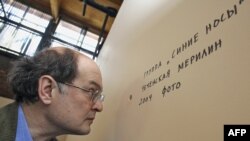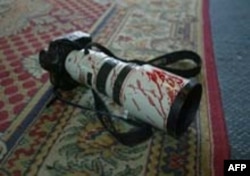
Russian state prosecutors have asked for a three-year jail sentence for the organizers of a controversial art exhibition three years ago, RFE/RL's Russian Service reports.
The organizers of the 2007 "Forbidden Art" exhibit -- former Sakharov Museum Director Yuri Samodurov and art historian Andrei Yerofeyev -- are on trial on charges of "debasing the religious beliefs of citizens and inciting religious hatred."
Prosecutors made the request on June 21.
The exhibition was comprised of art that had not been authorized for exhibition in Russia. Many of the works are a Soviet realist style and combined Soviet and religious iconography. A painting by American artist Vagrich Bakhchanyan shows a Soviet-era medal of Vladimir Lenin superimposed on a cross so as to give the impression that the Bolshevik leader was being crucified.
Because the art being shown was considered to be shocking, the curators warned that the exhibition was not suitable for children under 16.
Former world chess champion and opposition leader Garry Kasparov and Vladimir Ryzhkov, an economics professor in Moscow and former Duma deputy, testified in defense of the exhibition.
"In this country, people are basically censored from saying their own opinion, in this case though art," Kasparov told RFE/RL last month.
"You can agree or disagree with artistic expression, but it is glaringly apparent that this discussion is not about antireligious propaganda or the agitation of religious followers."
"Forbidden Art" was to be part of a yearly cycle of shows organized by the Sakharov Museum and focused on analyzing and debating censorship of culture and art. But they were discontinued after the controversy triggered by the 2007 exhibit.
The organizers of the 2007 "Forbidden Art" exhibit -- former Sakharov Museum Director Yuri Samodurov and art historian Andrei Yerofeyev -- are on trial on charges of "debasing the religious beliefs of citizens and inciting religious hatred."
Prosecutors made the request on June 21.
The exhibition was comprised of art that had not been authorized for exhibition in Russia. Many of the works are a Soviet realist style and combined Soviet and religious iconography. A painting by American artist Vagrich Bakhchanyan shows a Soviet-era medal of Vladimir Lenin superimposed on a cross so as to give the impression that the Bolshevik leader was being crucified.
Because the art being shown was considered to be shocking, the curators warned that the exhibition was not suitable for children under 16.
Former world chess champion and opposition leader Garry Kasparov and Vladimir Ryzhkov, an economics professor in Moscow and former Duma deputy, testified in defense of the exhibition.
"In this country, people are basically censored from saying their own opinion, in this case though art," Kasparov told RFE/RL last month.
"You can agree or disagree with artistic expression, but it is glaringly apparent that this discussion is not about antireligious propaganda or the agitation of religious followers."
"Forbidden Art" was to be part of a yearly cycle of shows organized by the Sakharov Museum and focused on analyzing and debating censorship of culture and art. But they were discontinued after the controversy triggered by the 2007 exhibit.






